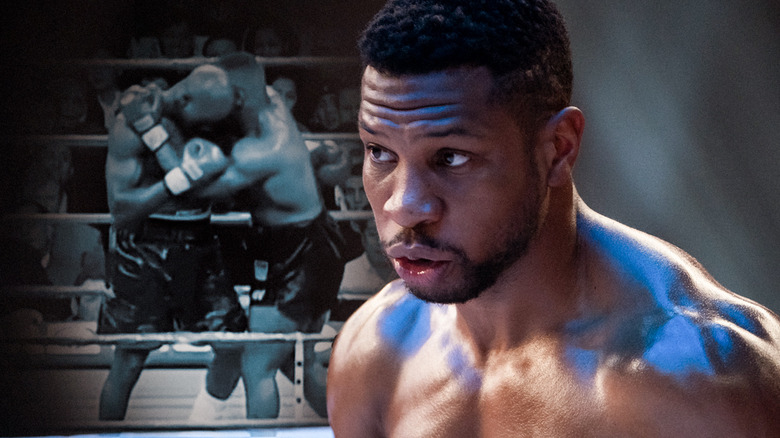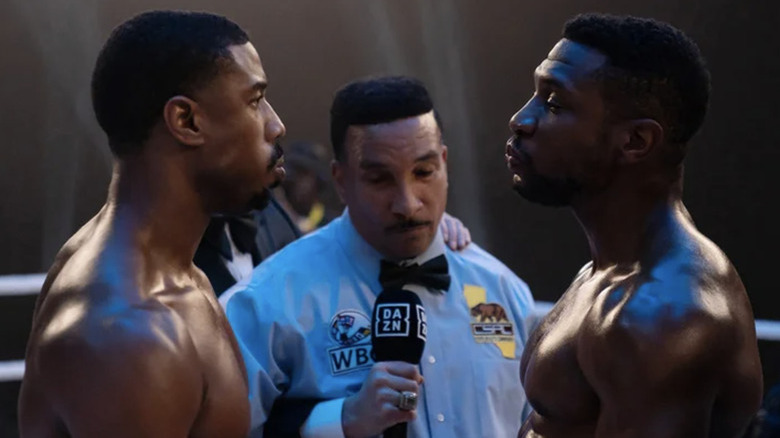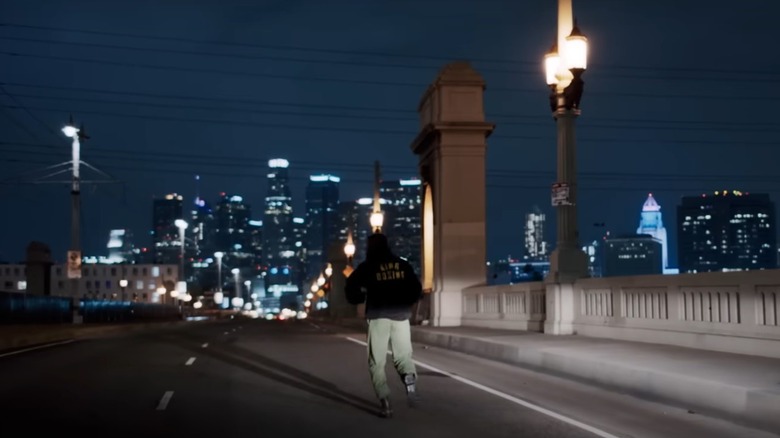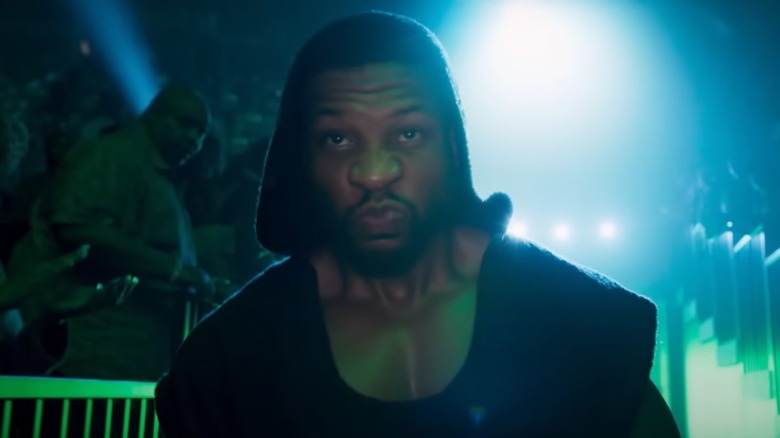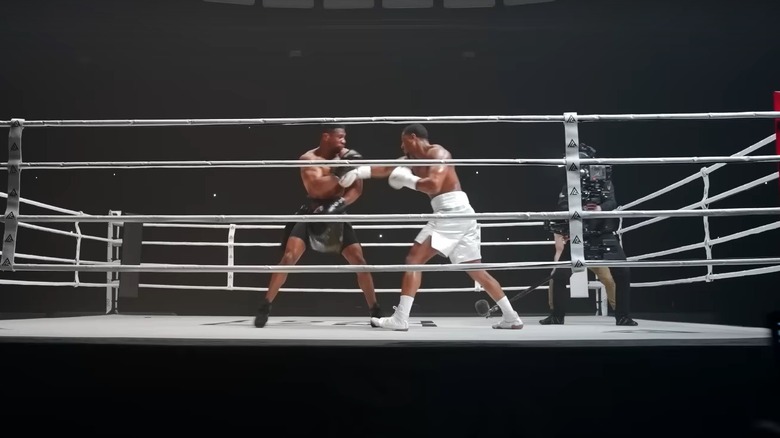Creed III Has Some Deep Cut Details That Will Delight Boxing Fans
In its initial opening weekend, "Creed III" genuinely knocked out box office expectations (and records), its competition, and prior "Rocky" first weekends all in one punch. This third franchise entry sees Adonis Creed (Michael B. Jordan) confronted by his past in the form of childhood-friend-turned-enemy Damian "Dame" Anderson (Jonathan Majors). Following an early situation that left Dame locked up while Adonis got away, Dame reemerges after almost two decades' incarceration with dreams of restoring his once-promising early boxing career. It's yet another memorable performance from the electric Majors in bringing Dame to life, alongside Michael B. Jordan expanding the "Creed" universe as both filmmaker and star.
While "Creed III" certainly boasts great performances and stunningly executed fights, one of its greatest elements is the film's attention to detail, showcasing the filmmakers' love for and knowledge of the sport of boxing. Woven into Dame's arc, character, style, and fighting habits are a number of subtle nods to famed fighters of yore, heavyweight champs in their own right. It's also loaded with fighters, refs, announcers, and other details that build out the realism of its boxing universe, details that the casual fan might miss.
A coterie of cameos
The "Rocky" and "Creed" films have long boasted boxing champions in their respective casts with loads of announcer and referee cameos. The "Rocky" franchise cast real-life champions like Tommy Morrison and Antonio Traver as antagonists, while "Creed" antagonist Ricky Conlan is played by champion boxer Tony Bellew. It's a franchise that pulls in real talent and loads of cameos whenever possible.
"Creed III" brings in cameos by some of the very best pound-for-pound fighters in the world. In the circus around Dame's fight against "Creed III" heavyweight Felix Chavez, champion Saúl "Canelo" Álvarez poses with Adonis, while Terence Crawford is both featured in the fight's lead-up and later in Adonis' final training camp.
The film is littered with other cameos, like broadcasters Chris Mannix, Todd Grisham, Jessica McCaskill, Al Bernstein, and Mauro Ranallo, referees Kenny Bayless, Russell Mora, and Tony Weeks, and ring announcers Jimmy Lennon Jr. and David Diamante–and here's the best detail. DAZN announcer Diamante has a now-unique announcing style with a great boxing history, one that made it into the final film.
While announcing the competing fighters, Diamante repeats the last names once (aka "Damian Anderson... Anderson"). It's a tradition he borrowed from classic announcers like Mark Bureau and Ed Derian, a throwback to the era when bouts had poor speaker systems. Announcers would repeat the names in order for different parts of an arena to hear the fighters' names. It's rare now due to the widespread availability of great AV setups, but it's a wonderful tradition to include in Diamante's "Creed III" cameo.
Dame's old-school training methods
The "Rocky" and "Creed" films are widely known for their training montages. They are so synonymous for top-shelf montages, in fact, that genuine debate can be had about which film has the "best" training montage. They're exciting windows into the lengths characters go to in order to be, typically, heavyweight champion of the world, while showcasing the grit and determination of major characters.
When it comes to training, neither Adonis Creed nor Dame Anderson takes it lightly. "Creed III" sees protagonist Adonis Creed take on a variety of memorable, Epic Poem Hero training challenges, like running to the peak of the Hollywood sign, punching trees like they insulted his jab, and most memorably, towing a plane. Dame Anderson's training is notable, however, for its connection to some classic boxing training methods.
While Adonis follows the modern approach of doing boxers' roadwork in cutting-edge, modern shoes designed for those athletic activities, Dame takes the classic, old-timey approach: he trains in construction boots as classic fighters did. As boxing legend Joe Frazier explains in his book Box Like The Pros, "I tell my fighters to wear what I wore and what the fighters in the old days wore: construction boots, or work boots." It's decidedly less common these days, but Dame's training is clearly following the classic method.
Dame's ring walks are one hundred percent Mike Tyson
Perhaps the key way "Creed III" honors boxing history is through the subtleties of Dame's ring walk and boxing style. In his fight against reigning champ Felix Chavez, Chavez's ring walk is full of style and theatrics, while Dame comes out simply and directly, eschewing robes in favor of black boots, black shorts, and a simple shirt, and an intense and largely solitary, music-accompanied march to the ring. It's a simple and stripped-down style and approach to the ring walk, one shared by a real-life controversial heavyweight champ who resumed a boxing career after incarceration: Mike Tyson.
Tyson's ring walks were very similar to Dame's strategy – stripped down and intense, wearing black boots and shorts, sometimes shirtless or in a simple shirt or v-neck, with Dame's ring walk outfit vs. Felix looking considerably like an all-black version of what Tyson wore in his 1990 bout against Henry Tillman. Tyson's last real-world fight as a competitive, top-shelf champion would come in 2002 (versus Lennox Lewis), a fight he lost in the eighth round by a straight right knockout. Tyson continued to fight, but the knockout effectively ended his career atop the division, and it happened the year Dame Anderson was arrested in "Creed III," 2002.
Dame adopted the rare guard of George Foreman's second act
While Dame Anderson seemed to take ring walk and outfit inspiration from Mike Tyson, he took his defensive style from another hard-hitting champion: George Foreman. One of the first scenes in "Creed III" involves young Adonis giving a gift to the young Golden Gloves winner Dame — a ticket to the 1974 Rumble in the Jungle between Muhammad Ali and George Foreman that ended with Ali knocking Foreman out in the eighth round. We know Dame took that ticket with him to jail, because he later sent it to Adonis in a letter.
What's interesting is that, in the early fight we see Dame participate in, his defense is relatively standard. When he emerges from nearly two decades' incarceration, however, the now older Dame has an entirely different defensive style: the now-rare cross-armed defense, with a defender's arms crossing horizontally across the chest or head in defense rather than a more traditional, vertical guard. It's a rare guard these days, but it was used by notable boxers like Archie Moore, and adopted by his pupil (you guessed it): George Foreman.
Like Dame adopting the cross-armed guard as an older fighter returning to the sport, when Foreman returned to boxing in 1987 after a ten-year hiatus, Moore taught him the cross guard that allowed him to become a world champion once more. Foreman fought on and off for another decade, becoming world champ again in 1994. It's a wonderful testament to the details in "Creed III" that Dame enters his unfortunate period of incarceration with a Foreman ticket, and leaves adopting Foreman's rare late-career defensive style, just as he adopts Mike Tyson's approach to ring walks and outfit style — two fighters with uniquely comparable second-act careers to his own.
"Creed 3" is now playing in theaters.
